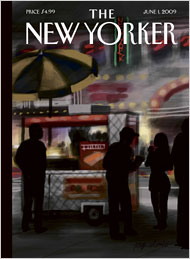Supporting Our Artists
Last week’s issue of The New Yorker attracted a lot of attention for its cover art, which was created on an iPhone by artist Jorge Colombo.

From the New York Times to gadget blogs to design sites, the work certainly got a lot of attention. But while a few stories did a decent job of talking to the artist behind the work in addition to covering the technology involved, most seemed like they were fixated on the tools instead of the end result. That’d be understandable if all of these venues were filled with people who’d never seen an iPhone before, but even the tech-savvy got pulled into the “gee whiz, a small computer can make pictures!” aspect of it.
The truth is, Colombo has been creating art for The New Yorker (albeit not covers) for a decade and a half — he didn’t suddenly become a recognized artist by using an iPhone. It’s not surprising that the magazine would encourage an established talent to use new media to express himself. But that odd fixation on tools over talent perhaps reached its apotheosis in the New York Times’s story on Brushes, Steve Sprang’s clever little app that Colombo used for his artwork. The piece offers a link for buying the application, but doesn’t explain how to buy any of Colombo’s work. While I’m glad to see the application’s creator recognized, it seemed odd that in all this coverage, very few people talked about how to support the artist who made the cover itself.
Fortunately, we have the means to support Jorge Colombo’s work within our community as well. Colombo has been featured on 20×200 a number of times, and in fact his iPhone editions made their debut back in April on the site, as Jen Bekman gleefully notes here.
So, go ahead and buy Brushes. That’s cool — Steve Sprang deserves to be rewarded for his creativity. But I think we should be recognizing Jorge Colombo as the artist who uses these tools as well. A work like this beautiful sketch of an interior at Grand Central Terminal starts at just $20. Our technologies are succeeding best when they become invisible or irrelevant compared to the ideas they’re being used to express.
